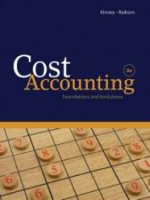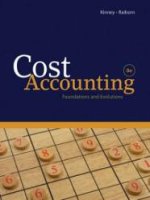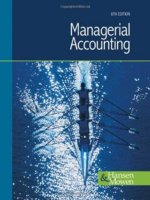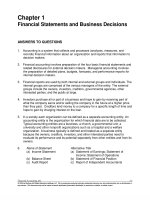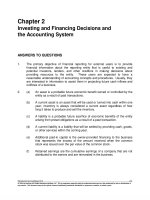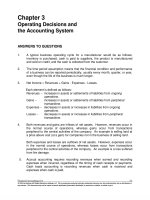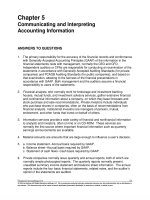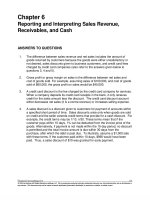Solution manual managerial accounting 8e by hansen mowen ch 15
Bạn đang xem bản rút gọn của tài liệu. Xem và tải ngay bản đầy đủ của tài liệu tại đây (265.64 KB, 46 trang )
To download more slides, ebook, solutions and test bank, visit
CHAPTER 15
QUALITY COSTS AND PRODUCTIVITY:
MEASUREMENT, REPORTING, AND CONTROL
QUESTIONS FOR WRITING AND DISCUSSION
1. Quality is meeting or exceeding customer
expectations on such dimensions as performance, features, reliability, and conformance.
10.
A quality cost report highlights quality costs,
reveals their magnitude and their relative
distribution among categories, and thus reveals the potential for improvement.
2. Reliability is the probability that a product or
service will function as intended for a specified period of time. Durability is how long the
product lasts.
11.
The AQL model assumes that it is costbeneficial to produce a certain percentage of
defective products. The zero-defects model
assumes that producing any defective unit is
more costly than preventing its production.
12.
There are two key differences. First, the
robust model tightens the definition of what
is meant by a defective product— any product not meeting a target value. Second, the
robust model assumes that it is very costly
to vary from the target value, thus providing
additional opportunity to decrease quality
costs by improving quality.
13.
Multiple-period trend analysis is used to
track the effects of quality-improvement efforts by assessing the changes that occur
over time.
14.
Total productive efficiency is the point where
technical and input trade-off efficiency are
achieved. It is the point where the optimal
quantity of inputs is used to produce a given
output.
15.
If the productivity ratio (output/input) has
only one input, then it is a partial measure. If
all inputs are included, then it is a total
measure of productivity.
16.
Partial measures can be misleading because they do not consider possible tradeoffs among inputs. They do, however, allow
some assessment of how well individual factors are being used and, additionally, often
serve as input to total measures. Total
measures are preferred because they provide a measure of the overall change in
productivity and allow managers to assess
trade-offs among inputs.
3. Quality of conformance refers to the ability
of a product to meet or exceed its specifications.
4. The traditional view requires a product to
conform to specifications that allow acceptable deviations from a target value. The robust view requires the product to meet the
target value.
5. Quality costs are the costs incurred because
poor quality may exist or poor quality does
exist. Thus, they are incurred because of
doing things wrong.
6. Prevention costs are incurred to prevent
poor quality; appraisal costs are incurred to
determine whether products are conforming
to specifications; internal failure costs are
incurred when nonconforming products are
detected prior to shipment; external failure
costs are incurred because nonconforming
products are delivered to customers.
7. External failure costs can be the most devastating because of the warranty costs,
lawsuits, and damage to the reputation of a
company, all of which may greatly exceed
the costs of rework or scrap incurred from
internal failure costs.
8. Hidden quality costs are opportunity costs
that are not recorded by the organization’s
accounting records. Lost sales due to poor
quality is an example.
9. The three methods for estimating hidden
quality costs are the multiplier method, the
market research method, and the Taguchi
quality loss function.
501
To download more slides, ebook, solutions and test bank, visit
ciency, for example, moving from departmental manufacturing to cellular manufacturing.
17. Productivity improvement must be measured
with respect to a standard, generally the
productivity of a prior period.
18. Profit-linked productivity measurement is an
assessment of the amount of profit change,
from the base period to the current period,
attributable to productivity changes.
22.
Productivity and quality both offer opportunities to decrease costs and become more efficient and thus more competitive.
23.
Quality is concerned with ensuring that
products are produced according to specifications, and productivity is concerned with
producing the output efficiently. Quality can
improve productivity, since improving quality
generally means using less inputs and becoming more efficient. Productivity, however, can be improved without quality improvements.
24.
Gainsharing is establishing financial incentives for productivity and quality performance targets. The idea is to share any
quality and productivity gains with the employees who create them.
19. Profit-linked productivity measurement allows managers to assess the economic effects of productivity improvement programs.
It also allows valuation of input trade-offs, a
critical element in planning productivity
changes.
20. The price-recovery component is the difference between the total profit change and the
change attributable to productivity effects.
21.
Yes. Even if there are zero defects, there
are still ways of improving input-usage effi-
502
To download more slides, ebook, solutions and test bank, visit
EXERCISES
15–1
1.
2.
3.
4.
5.
6.
7.
e
e
b
a
c
b
d
8.
9.
10.
11.
12.
13.
14.
b
d
e
c
b
a
d
15–2
1.
2.
3.
4.
5.
6.
7.
8.
9.
10.
11.
12.
13.
14.
15.
16.
17.
18.
19.
20.
21.
22.
23.
Internal failure
Appraisal
Internal failure
External failure
External failure
Prevention
Prevention
Appraisal
External failure
Internal failure
External failure
Appraisal
503
Prevention
Internal failure
External failure
Appraisal
External failure
Internal failure
Prevention
Appraisal
External failure
Prevention
Internal failure
To download more slides, ebook, solutions and test bank, visit
15–3
1. Multiplier method: 4 × $10,000,000 = $40,000,000
2. Taguchi: 12.5 × $80 × 45,000 = $45,000,000
15–4
1.
Quality Cost Report
Wilmington Company
For the Year Ended December 31, 2007
Percentage of
Sales
Quality Costs
Prevention costs:
Design review
Quality training
$150,000
40,000
$ 190,000
Appraisal costs:
Materials inspection
Process acceptance
Product inspection
$ 60,000
0
50,000
110,000
1.83
Internal failure costs:
Reinspection
Scrap
$100,000
145,000
245,000
4.08
External failure costs:
Recalls
Lost sales
Returned goods
$200,000
300,000
155,000
655,000
10.92
Total quality costs
$1,200,000
504
3.17%
20.00%
To download more slides, ebook, solutions and test bank, visit
15–4
Concluded
Quality Cost Report
Wilmington Company
For the Year Ended December 31, 2008
Quality Costs
Percentage of
Sales
Prevention costs:
Design review
Quality training
$300,000
100,000
$ 400,000
Appraisal costs:
Materials inspection
Process acceptance
Product inspection
$ 40,000
50,000
30,000
120,000
2.00
Internal failure costs:
Reinspection
Scrap
$ 50,000
35,000
85,000
1.42
External failure costs:
Recalls
Lost sales
Returned goods
$100,000
200,000
95,000
395,000
6.58
Total quality costs
$1,000,000
6.67%
16.67%
The quality cost report communicates two major outcomes. First, the total
quality costs as a percentage of sales is quite high (20%), indicating that
there are significant opportunities to improve quality and reduce quality
costs. Second, most of the quality costs are failure costs and more investment in control costs are needed.
2. (Percentages are rounded to two decimal places)
Prevention
Appraisal
Internal failure
External failure
Percentage of
Total Quality Costs
2007
2008
0.16
0.40
0.09
0.12
0.20
0.09
0.55
0.40
In 2007 the control costs are 25% and the failure costs are 75% of total quality
costs. From 2007 to 2008, the company significantly increased its investment in
control costs.
505
To download more slides, ebook, solutions and test bank, visit
15–5
1.
Quality Cost Report
Norton Company
For the Year Ended December 31, 2007
Percentage of
Sales
Quality Costs
Prevention costs:
Field trials
Quality training
$ 450,000
120,000
Appraisal costs:
Packaging inspection
Process acceptance
Product inspection
570,000
3.17%
$ 180,000
0
150,000
330,000
1.83
Internal failure costs:
Reinspection
Retesting
$ 300,000
435,000
735,000
4.08
External failure costs:
Recalls
Lost sales
Complaint adjustment
$ 600,000
900,000
465,000
1,965,000
10.92
Total quality costs
$
$ 3,600,000
506
20.00%
To download more slides, ebook, solutions and test bank, visit
15–5
Concluded
Quality Cost Report
Norton Company
For the Year Ended December 31, 2008
Quality Costs
Percentage of
Sales
Prevention costs:
Field trials
Quality training
$ 900,000
300,000
$ 1,200,000
Appraisal costs:
Packaging inspection
Process acceptance
Product inspection
$ 120,000
150,000
90,000
360,000
2.00
Internal failure costs:
Reinspection
Retesting
$ 150,000
105,000
255,000
1.42
External failure costs:
Recalls
Lost sales
Complaint adjustment
$ 300,000
600,000
285,000
1,185,000
6.58
Total quality costs
$ 3,000,000
2.
Additional investment = Increase in control costs
Control costs increase = $1,560,000 – $900,000 = $660,000
Failure costs reduction = $2,700,000 – $1,440,000 = $1,260,000
A $1,260,000 benefit for a $660,000 investment is certainly sound!
3.
(0.1667 – 0.025)$18,000,000 = $2,550,600
6.67%
16.67%
The 2.5 percent goal is the level many quality experts identify as the one that
companies should strive to obtain. The experiences of real-world companies
such as Tennant Company show that it is an achievable goal. Also, although
most Japanese companies do not track quality costs, some have measured
their costs of quality and they generally tend to be less than 5 percent compared with the U.S. experience of 20 to 30 percent.
507
To download more slides, ebook, solutions and test bank, visit
15–6
1.
2001: $12,000,000/$48,000,000 = 0.25
2008: $1,500,000/$60,000,000 = 0.025
Over a seven-year period, the quality costs-to-sales ratio improved from 25
percent to 2.5 percent. The 2.5 percent ratio is achievable as evidenced by the
experiences of real-world companies, [for example, Tennant Company reduced its costs-to-sales ratio from 17 percent to 2.5 percent over an eightyear period (1980 to 1988)].
2.
Internal failure:
External failure:
Appraisal:
Preventive:
$3,600,000/$12,000,000
$4,800,000/$12,000,000
$2,160,000/$12,000,000
$1,440,000/$12,000,000
= 30%
= 40%
= 18%
= 12%
The percentage of quality costs spent on internal and external failures is too
high. If costs are reduced to 2.5 percent, then the company is approaching the
goal of zero defects. As the zero-defect level is approached, failure costs will
approach zero, leaving the bulk of quality costs in the prevention and appraisal categories. Of these two categories, the prevention category would
likely dominate.
3.
Internal failure:
External failure:
Appraisal:
Preventive:
$180,000/$1,500,000
$120,000/$1,500,000
$450,000/$1,500,000
$750,000/$1,500,000
= 12%
= 8%
= 30%
= 50%
Quality costs are distributed better than in 2001. Control costs account for 80
percent of the total quality costs (versus only 30 percent in 2001). Failure
costs have shrunk from 70 percent of the total in 2001 to only 20 percent in
2008. Moreover, total quality costs have shrunk from 25 percent of sales to
2.5 percent of sales. Costs in every category have been reduced. Failure
costs are now only 0.5 percent of sales, which practice indicates is an empirical possibility. From an activity-based management perspective, further reductions are possible, at least in the failure categories. These are nonvalueadded costs and, in theory, can be reduced to zero.
508
To download more slides, ebook, solutions and test bank, visit
15–6
4.
Concluded
Gainsharing provides a strong incentive for managers to improve quality and
reduce quality costs. Gainsharing is a good idea provided the incentive system is carefully designed. The bonus must be truly based on quality improvements. Quality gains, stemming from quality cost reductions, must flow
from true quality improvements. Thus, there should be operational quality
measures that provide evidence of actual quality improvements. One possibility is to base bonuses only on reductions in failure and appraisal categories.
This provides an incentive for managers to invest in preventive activities—
actions that should reduce “poor” quality costs.
15–7
1.
Only four of the activities should be implemented: quality training, process
control, supplier evaluation, and engineering redesign. Each of these four activities reduces failure costs more than it costs to implement the activity (thus
increasing the bonus pool). The cost reduction for failures is less than the
amount spent for product inspection and prototype testing.
Total quality costs:
Current control
Quality training
Process control
Supplier evaluation
Redesign
Failure costs
$ 200,000
200,000
250,000
150,000
50,000
230,000*
$1,080,000
*$50,000 + ($900,000 – $820,000) + ($250,000 – $150,000) (adds back cost reductions of two activities not implemented)
509
To download more slides, ebook, solutions and test bank, visit
15–7
2.
Concluded
a. Total quality costs were reduced by $920,000 ($2,000,000 – $1,080,000).
Quality training increased costs by $200,000 but reduced failure costs by
$500,000, for a net gain of $300,000. Process control increased costs by
$250,000 but decreased failure costs by $400,000, for a net gain of
$150,000. Supplier evaluation increased costs by $150,000 but decreased
failure costs by $570,000, for a net gain of $420,000. Engineering redesign
increased costs by $50,000 but decreased failure costs by $100,000, for a
net gain of $50,000.
Total net gain:
$300,000
150,000
420,000
50,000
$920,000
b. Distribution percentage:
Control costs: $850,000/$1,080,000 = 79% (rounded)
Failure costs: $230,000/$1,080,000 = 21% (rounded)
c. Bonus pool = 0.10 × $920,000 = $92,000
3.
All of the same activities would be adopted plus prototype testing. Of the activities adopted, training, supplier evaluation, engineering redesign, and prototype testing are all prevention activities and so would not be counted in the
cost reduction calculation. Failure costs would now be $130,000 (prototype
addition reduces failure costs by an additional $100,000). The initial failure
and appraisal costs are $2,000,000 ($1,800,000 + $200,000). The ending failure
and appraisal costs are the sum of the current appraisal costs, ending failure
costs, and the cost of adding process control: $200,000 + $130,000 + $250,000
= $580,000. Thus, the cost reductions counted for the bonus pool would be
$1,420,000 ($2,000,000 – $580,000), and the bonus would be $142,000 (0.10 ×
$1,420,000). There is some merit to this approach as it encourages managers
to invest in value-added activities and avoid the temptation of reducing prevention costs prematurely. It is possible, however, that some prevention activities are not really worth doing and this approach may lead to an overinvestment in this category.
510
To download more slides, ebook, solutions and test bank, visit
15–8
1.
Quality Cost Report
Emery Manufacturing
For the Year Ended December 31, 2008
Percentage of
Sales
Quality Costs
Prevention costs:
Training program
Supplier evaluation
$ 36,000
9,000
Appraisal costs:
Test labor
Inspection labor
$ 90,000
75,000
165,000
5.5
Internal failure costs:
Scrap
Rework
$ 90,000
120,000
210,000
7.0
External failure costs:
Consumer complaints
Warranty
$ 60,000
120,000
180,000
6.0
600,000
20.0%
Total quality costs
2.
Prevention
Appraisal
Internal failure
External failure
$
$
7.5%
27.5%
35.0%
30.0%
45,000
1.5%
(0.015/0.20)
(0.055/0.20)
(0.07/0.20)
(0.06/0.20)
Only 35 percent of the total costs are control costs. This suggests a need to
push down failure costs by increasing control costs.
3.
Hidden costs: $5 × 50,000 = $250,000. This changes the relative distribution to
24.7 percent control costs ($210,000/$850,000) and 75.3 percent failure costs
($640,000/$850,000). Adding the hidden costs to the total provides a greater
incentive to invest in control costs to drive down the failure costs.
511
To download more slides, ebook, solutions and test bank, visit
15–9
1.
L = k(Y – T)2
where k = $120 and T = 32
Unit
1
2
3
4
5
Measured Weight
32.30
32.75
32.45
31.75
31.90
Y–T
0.30
0.75
0.45
–0.25
–0.10
Units
Average
2.
Hidden costs = $22.26 × 50,000 = $1,113,000
512
(Y – T)2
0.0900
0.5625
0.2025
0.0625
0.0100
0.9275
÷
5
0.1855
k(Y – T)2
$ 10.80
67.50
24.30
7.50
1.20
$ 111.30
÷
5
$ 22.26
To download more slides, ebook, solutions and test bank, visit
15–10
There has been a steady downward trend in quality costs expressed as a percentage of sales. Costs declined in the last year so it is possible to reduce
costs more. Overall, the percentage has decreased from 29 percent to 12 percent, a significant improvement.
Trend in Total Quality Costs
35
Percentage of Sales
1.
30
25
20
15
10
5
0
2004
2005
2006
Year
513
2007
2008
To download more slides, ebook, solutions and test bank, visit
15–10 Concluded
2.
Trend by Quality Cost Category
14
Percentage of Sales
12
10
8
6
4
2
0
2004
2005
2006
2007
2008
Year
Prevention
Appraisal
Internal Failure
External Failure
There have been significant reductions in internal and external failure costs.
Prevention costs have increased, while appraisal costs have remained the
same. The graph reveals the trend for each category of costs. It also reveals
how management is changing the expenditure pattern for each category. In
2004, a greater percentage of sales was spent on external and internal costs
than for appraisal and prevention costs. By contrast, in 2008, the amount
spent on internal and external failures is less than the amount spent on appraisal and prevention. The strategy of shifting more resources to appraisal
and prevention seems to have worked since total quality costs have dropped
from 29 percent to 12 percent.
514
To download more slides, ebook, solutions and test bank, visit
15–11
1. Output-input ratios:
Materials
Labor
2007
10,000/2500 = 4.0
10,000/8,000 =1.25
2008
10,000/2,000 = 5.0
10,000/5,000 = 2.0
Both materials and labor productivity improved and so overall productivity
improved.
2. For this scenario, the partial productivity ratio for labor is 1.00 (10,000/10,000)
for 2008; thus, productivity went down for labor (from 1.25 to 1.00. In this
case, materials productivity improved while labor productivity declined. The
solution is to value the tradeoffs for the two inputs using the input prices:
Value of materials savings: (2,500 – 2,000)$8 = $4,000
Cost of increased labor: (8,000 – 10,000)$10 = ($20,000)
Thus, the cost of inputs increased by $16,000 signaling an overall decline in
productivity.
15–12
1. Output-input ratios (Combination A):
Energy: 400/200 = 2.00
Labor: 400/800 = 0.50
Yes, there is improvement. Current productivity is as follows:
Energy: 400/320 = 1.25
Labor: 400/1,280 = 0.31*
Since 2 > 1.25 and 0.50 > 0.31, Combination A dominates the current input
combination, and productivity would definitely improve.
Cost of current input combination: ($18 × 320) + ($15 × 1,280) = $24,960
Cost of input Combination A:
($18 × 200) + ($15 × 800) = 15,600
Value of productivity improvement
9,360
This improvement is all attributable to technical efficiency. The same output
is produced with proportionately less inputs (note that the inputs are in the
same ratio, 1:4, and that Combination A reduces each input in the same proportion).
*Rounded
515
To download more slides, ebook, solutions and test bank, visit
2.
Output-input ratios (Combination B):
Energy: 400/320 = 1.25
Labor: 400/500 = 0.80
Compared to the current use, productivity is the same for energy and better
for labor (1.25 = 1.25 and 0.80 > 0.31).
Compared to Combination A, however, Combination B has lower productivity
for energy (1.25 < 2.00) and higher productivity for labor (0.80 > 0.50). Tradeoffs must be considered.
3.
Cost of Combination B: ($18 × 320) + ($15 × 500) = $ 13,260
Cost of Combination A:
15,600
Difference
$ (2,340)
Combination B is a less costly input combination than A. Thus, less resources are used by B than A, and moving from A to B would be a productivity improvement (same output at a lower cost). This is an example of improving price (input trade-off) efficiency.
516
To download more slides, ebook, solutions and test bank, visit
15–13
1.
Partial operational productivity ratios:
2007 X:
2007 Y:
2008 X:
2008 Y:
96,000/12,000 = 8
96,000/24,000 = 4
120,000/12,000 = 10
120,000/35,000 = 3.43
Productivity improved for X but not for Input Y. We cannot say what happened to overall productivity using partial ratios because the signals are
mixed.
2.
Profit-linked productivity measurement:
Input X
Input Y
PQ*
15,000
30,000
PQ × P
$ 30,000
150,000
$180,000
AQ
12,000
35,000
AQ × P
(PQ × P) – (AQ × P)
$ 24,000
$ 6,000
175,000
( 25,000)
$199,000$(
19,000)
*Input X: 120,000/8 = 15,000; Input Y: 120,000/4 = 30,000
Profits decreased by $19,000 due to productivity changes.
3.
Price recovery = Total profit change – Productivity-induced change
Total profit change:
[($2.50 × 120,000) – ($2 × 12,000) – ($5 × 35,000)] = $101,000
84,000
[($2 × 96,000) – ($1 × 12,000) – ($4 × 24,000)] =
$17,000
Price recovery = $17,000 + $19,000
= $36,000
Price recovery is the profit change that would have been realized without any
changes in productivity.
517
To download more slides, ebook, solutions and test bank, visit
15–14
1.
Partial ratios:
Materials
Labor
Capital
Base Year
200,000/50,000 = 4
200,000/10,000 = 20
200,000/10,000 = 20
Current Year
240,000/40,000 = 6.0
240,000/4,000
= 60.0
240,000/600,000 = 0.4
The increase in labor and materials productivity was caused by reducing labor and material usage by using more capital input.
2.
Profit-linked measurement:
Materials
Labor
Capital
PQ*
60,000
12,000
12,000
PQ × P
$120,000
60,000
1,800
$181,800
AQ
40,000
4,000
600,000
AQ × P
$ 80,000
20,000
90,000
$190,000
(PQ × P) – (AQ × P)
$ 40,000
40,000
(88,200)
$ (8,200)
*240,000/4; 240,000/20; 240,000/20
Profits decreased by $8,200 due to productivity changes. Assuming that this
outcome will persist, the trade-off was not favorable, and automating was a
poor decision.
518
To download more slides, ebook, solutions and test bank, visit
15–15
1.
Partial operational productivity ratios:
Materials
Labor
Energy
Status Quoa
0.56*
1.25
2.50
Proposal Ab
0.67*
1.50
3.00
Proposal Bc
0.60
2.00
3.00
a
250,000/450,000; 250,000/200,000; 250,000/100,000
300,000/450,000; 300,000/200,000; 300,000/100,000
c
300,000/500,000; 300,000/150,000; 300,000/100,000
b
Both proposals improve technical efficiency because more output is produced per unit of input for all inputs. A recommendation cannot be made
without valuing trade-offs.
*Rounded
2.
Profit-linked productivity measurement:
Proposal A:
Materials
Labor
Energy
PQ*
535,714
240,000
120,000
PQ × P
$ 4,285,712
2,400,000
240,000
$ 6,925,712
AQ
AQ × P
(PQ × P) – (AQ × P)
450,000 $ 3,600,000
$ 685,712
200,000
2,000,000
400,000
100,000
200,000
40,000
$ 5,800,000
$ 1,125,712
PQ*
535,714
240,000
120,000
PQ × P
$ 4,285,712
2,400,000
240,000
$ 6,925,712
AQ
AQ × P
(PQ × P) – (AQ × P)
500,000 $ 4,000,000
$ 285,712
150,000
1,500,000
900,000
100,000
200,000
40,000
$ 5,700,000
$ 1,225,712
Proposal B:
Materials
Labor
Energy
*300,000/0.56; 300,000/1.25; 300,000/2.5
The analysis favors Proposal B. Price efficiency is concerned with valuing
trade-offs. Once these trade-offs were valued, it became clear that Proposal B
was better than Proposal A.
519
To download more slides, ebook, solutions and test bank, visit
15–16
1.
Partial operational productivity ratios:
Without acquisition:
Materials: 10,000/40,000 = 0.25
Labor:
10,000/20,000 = 0.50
With acquisition:
Materials: 10,000/35,000 = 0.29*
Labor:
10,000/15,000 = 0.67*
Materials and labor productivity increase with the acquisition (as claimed by
the production manager).
*Rounded
2.
To compare the alternatives, all inputs must be considered:
Partial operational productivity ratios:
With
Without
Materials
0.29
0.25
Labor
0.67
0.50
Capital
0.10
0.50
Energy
0.40
1.00
The partial operational productivity ratios indicate a mixed outcome—some
improve and some do not. Trade-offs, therefore, must be valued.
3.
Profit-linked productivity measurement:
Materials
Labor
Capital
Energy
PQ*
40,000
20,000
20,000
10,000
PQ × P
$160,000
180,000
2,000
25,000
$367,000
AQ
35,000
15,000
100,000
25,000
AQ × P (PQ × P) – (AQ × P)
$140,000
$ 20,000
135,000
45,000
10,000
(8,000)
62,500
(37,500)
$347,500
$ 19,500
*10,000/0.25; 10,000/0.50; 10,000/0.50; 10,000/1.0
The trade-offs are favorable. The system will increase profitability by $19,500.
520
To download more slides, ebook, solutions and test bank, visit
15–17
1.
Partial operational productivity measures:
Materials
Labor
a
Base Yeara
0.75
3.00
Current Yearb
1.00
2.00
150,000/200,000; 150,000/50,000
180,000/180,000; 180,000/90,000
b
2.
Income statements:
Sales
Materials
Labor
Income
Base Year
$ 3,000,000
(1,000,000)
(400,000)
$ 1,600,000
Current Year
$ 3,600,000
(1,080,000)
(720,000)
$ 1,800,000
Change in income = $1,800,000 – $1,600,000
= $200,000
3.
Profit-linked productivity measurement:
Materials
Labor
PQ*
240,000
60,000
PQ × P
$1,440,000
480,000
$1,920,000
AQ
AQ × P
(PQ × P) – (AQ × P)
180,000 $1,080,000
$ 360,000
90,000
720,000
(240,000)
$1,800,000
$ 120,000
*180,000/0.75; 180,000/3.00
Change attributable to productivity = $120,000
4.
Price-recovery component = $200,000 – $120,000
= $80,000
In the absence of productivity changes, input costs would have increased by
$520,000 ($1,920,000 – $1,400,000), and this increase would have been more
than offset by the $600,000 increase in revenues, producing an $80,000 increase in profits. Price recovery is simply the amount by which profits will
change without considering any productivity changes. The productivity improvement adds an additional $120,000 so that total profits increased by
$200,000.
521
To download more slides, ebook, solutions and test bank, visit
PROBLEMS
15–18
1. Prevention
14. Internal failure
2. Internal failure
3. Internal failure
15. Appraisal
16. Prevention
4. External failure
17. External failure
5. Prevention
18. Appraisal
6. Appraisal
7. Internal failure
19. Prevention
20. Prevention
8. Prevention
21. External failure
9. Prevention
22. Appraisal
10. Internal failure
11. External failure
23. Appraisal
24. External failure
12. Appraisal
25. Appraisal
13. Internal failure
15–19
1. e
9. h
2. f
10. a
3. d
11. l
4. b
5. g
12. j
13. o
6. c
14. n
7. k
15. m
8. i
522
To download more slides, ebook, solutions and test bank, visit
15–20
1.
Percentage of
Sales
Quality Costs
Prevention costs:
Quality training
Appraisal costs:
Product inspection
Test equipment
Internal failure costs:
Scrap
Rework
External failure costs:
Repair
Order cancellation
Customer complaints
Sales allowances
$ 240,000
$450,000
360,000
810,000
$1,350,000
1,080,0002,430,000
$630,000
750,000
300,000
375,000
Total quality costs
0.80%
2.70
8.10
2,055,000
6.85
$5,535,000
18.45%
The president should be concerned because the quality cost ratio is 18.45
percent, and the quality costs are almost as large as income. Although the ratio is lower than the 20 to 30 percent range many companies apparently have
(or had), there is still ample opportunity for improvement. In fact, if quality is
improved to the point where quality costs are 2.5 percent of sales, total quality costs would be $750,000. Thus, improving quality offers a profit improvement potential of $4,785,000 ($5,535,000 – $750,000).
523
To download more slides, ebook, solutions and test bank, visit
15–20 Continued
2.
Prevention:
Appraisal:
Internal failure:
External failure:
$240,000/5,535,000
$810,000/5,535,000
$2,430,000/5,535,000
$2,055,000/5,535,000
= 4.4% (rounded up)
= 14.6%
= 43.9%
= 37.1%
It seems that 81 percent of the total quality costs are spent on failure costs.
These costs are nonvalue-added costs and should eventually be eliminated
(as eventually should appraisal costs, according to the results achieved).
Prevention and appraisal activities should be given much more emphasis. If
anything, experiences of real-world companies (e.g., Tennant and Westinghouse) indicate that the control costs should be 81 percent and the failure
costs 19 percent. The distribution of quality costs needs to be reversed!
3.
The fundamental principle that needs to be understood and emphasized is
that quality is essentially free. Quality costs exist because poor quality either
exists or may exist. The key, therefore, to reducing quality costs is improving
quality. The strategy advocated by the ASQC is directly attacking failure costs
to drive them to zero. This is done by investing in control activities, particularly prevention activities, reducing appraisal costs as appropriate. It assumes that there is a root cause for each failure, that it is preventable, and
that the costs of prevention are always less than failure. Activity management
can play an important role in this effort. For Troy Company, activity selection
and activity reduction are vital elements. More attention needs to be paid to
control activities, especially prevention. More than quality training is needed.
Other prevention activities like quality engineering, quality planning, design
verification, and statistical process control could bring significant benefits.
Initially, more may be spent as these activities are introduced to reduce the
internal and external failure activities.
524
To download more slides, ebook, solutions and test bank, visit
15–20 Concluded
4.
Total costs of quality = 0.025 × $30,000,000 = $750,000
Control costs: 0.80 × $750,000 = $600,000
Failure costs: 0.20 × $750,000 = $150,000
Profit improvement = $4,785,000 ($5,535,000 - $750,000)
5.
Bonus pool = 0.20 × $4,785,000 = $957,000. Establishing a bonus pool allows
employees to share in the gains from quality and thus provides an incentive
to improve quality. Pay-for-performance plans, however, must be carefully
designed. Paying for reductions in quality costs is OK provided the cost reductions actually are due to quality improvements. The suggestion by the
quality manager addresses this very issue. By exempting prevention costs
and paying only for reductions in nonvalue-added costs, the incentive is to
invest in prevention activities and to reduce failure and appraisal activities. A
good suggestion, but it carries with it the risk of overinvesting in prevention
activities.
6.
Actual external failure costs = 3 × $2,055,000 = $6,165,000. Other methods besides the multiplier approach are market research and the Taguchi quality
loss function. Knowing the hidden failure costs provides additional justification for investing in prevention activities. The hidden costs strengthen the
case for a vigorous quality improvement program. Including the costs in the
bonus pool would perhaps strengthen the incentive to improve quality and
also increase the awareness of how important quality is to customers. The
downside is the fact that these costs are not directly observable and must be
estimated each year. If included, total quality costs increase by $4,110,000
(6,165,000 – 2,055,000) (in the initial year). Since quality costs are reduced to
$750,000, this means that the quality cost reductions also increase by
$4,110,000. Thus, the bonus pool for the five-year period would be increased
by $822,000 (0.20 × $4,110,000).
525
